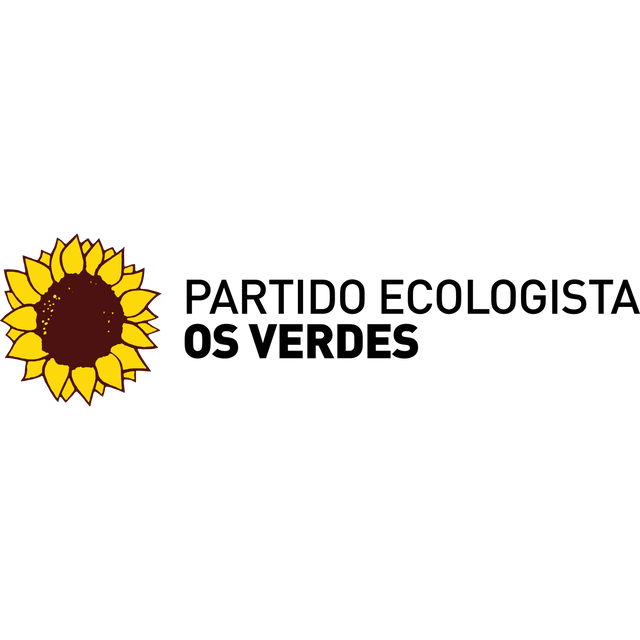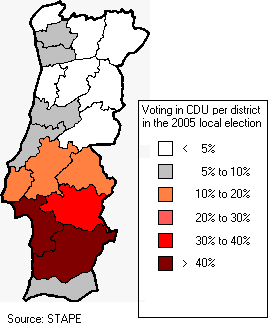Ecologist Party "The Greens"

Ecologist Party "The Greens"

Ecologist Party "The Greens" Partido Ecologista "Os Verdes" | |
|---|---|
| Abbreviation | PEV |
| Leader | Heloísa Apolónia |
| Founded | 19 May 1982 (1982-05-19) |
| Headquarters | Rua da Boavista 83, 3.º Dto, 1200-066 Lisbon |
| Newspaper | Folha Verde |
| Youth wing | Ecolojovem |
| Membership | 6,000 |
| Ideology | Eco-socialism[1] Green politics[1] |
| Political position | Left-wing[2] |
| National affiliation | Unitary Democratic Coalition |
| European affiliation | European Green Party |
| International affiliation | Global Greens |
| European Parliament group | Greens–European Free Alliance |
| Colours | Green |
| Assembly of the Republic | 2 / 230 |
| European Parliament | 0 / 21 |
| Regional parliaments | 0 / 104 |
| Local Government | 3 / 2,086 |
| Party flag | |
| Website | |
| www.osverdes.pt [14] | |
| |
The Ecologist Party "The Greens" (Portuguese: Partido Ecologista "Os Verdes", pronounced [pɐɾˈtidu ekuluˈʒiʃtɐ uʒ ˈveɾdɨʃ], PEV) is a Portuguese eco-socialist[1] political party. It is a member of the European Greens and a founding member of the European Federation of Green Parties.[3]
It was the first Portuguese ecologist party, and since its foundation, in 1982, the PEV has had a close relationship with the Portuguese Communist Party and after participating allied with it in the Unitary Democratic Coalition in all the elections, the PEV holds many mandates in local assemblies and two seats in the Assembly of the Republic.[4]
Ecologist Party "The Greens" Partido Ecologista "Os Verdes" | |
|---|---|
| Abbreviation | PEV |
| Leader | Heloísa Apolónia |
| Founded | 19 May 1982 (1982-05-19) |
| Headquarters | Rua da Boavista 83, 3.º Dto, 1200-066 Lisbon |
| Newspaper | Folha Verde |
| Youth wing | Ecolojovem |
| Membership | 6,000 |
| Ideology | Eco-socialism[1] Green politics[1] |
| Political position | Left-wing[2] |
| National affiliation | Unitary Democratic Coalition |
| European affiliation | European Green Party |
| International affiliation | Global Greens |
| European Parliament group | Greens–European Free Alliance |
| Colours | Green |
| Assembly of the Republic | 2 / 230 |
| European Parliament | 0 / 21 |
| Regional parliaments | 0 / 104 |
| Local Government | 3 / 2,086 |
| Party flag | |
| Website | |
| www.osverdes.pt [14] | |
| |
History and general information
The Party was founded 1982,[5] originally named the Portuguese Ecologist Movement – Party "The Greens" (Movimento Ecologista Português – Partido "Os Verdes"), by a group of Portuguese citizens interested in the promotion of the ecologist movement in Portuguese society, with the support of the Portuguese Communist Party, including in its founders one of its members, Zita Seabra.
In the end of the 1970s, Earth was facing new ecological problems, such as the greenhouse effect and the depletion of the ozone layer and the lack of awareness of this in Portuguese society, along with the lack of an organized Ecologist movement, led to the foundation of the Ecologist Party "The Greens" in order to put such problems on the political agenda.
The Party created regional groups immediately following its foundation, groups that have continued to grow since then. The growth of the Party throughout the country allowed many members to integrate the electoral lists of the CDU, some being elected to very different tasks. Currently (as of 2018), The PEV has several members elected in Municipal Assemblies and Parish Assemblies, as well as two members elected in the Assembly of the Republic (Portuguese parliament). Those two members are Heloísa Apolónia[6] and José Luís Ferreira.[6] There is some criticism of its close ties to the Communist Party. Given that PEV never stood in elections on its own, some right-wing politicians have gone to the point of nicknaming PEV "The Watermelons – Greens Outside, Reds Inside". However, official positions of both parties on certain questions can be quite different.
The PEV is also present in the National Electoral Commission and also in the National Council of Education. The youth wing of the Party is the Ecolojovem, founded in 1989, which is a founding member of the Federation of Young European Greens.[7]
The PEV edits a newspaper, the Folha Verde (Green Leaf), which received several press prizes for its unique design and style.
The PEV supported the minority Socialist Costa Government (2015-2019) with a confidence and supply agreement.
Electoral results

CDU results in the local election of 2005. (Azores and Madeira are not shown)
In elections, the PEV is closely allied with the Portuguese Communist Party, first in the Unitary Democratic Coalition. This explains a nickname given to Os Verdes by some: "melancias" (lit. watermelons): green outside, red inside.
Results in parliamentary elections
| Results in Parliamentary Elections [8](year links to election page) | ||||||||
|---|---|---|---|---|---|---|---|---|
| Year | Coalition | Type of Election | Voting | % | Mandates | |||
| 1987 | CDU | Portuguese Parliament | 685,109 | 12.2% | 31 (2) | |||
| 1991 | CDU | Portuguese Parliament | 501,840 | 8.8% | 17 (2) | |||
| 1995 | CDU | Portuguese Parliament | 504,007 | 8.6% | 15 (2) | |||
| 1999 | CDU | Portuguese Parliament | 483,716 | 9.0% | 17 (2) | |||
| 2002 | CDU | Portuguese Parliament | 378,640 | 7.0% | 12 (2) | |||
| 2005 | CDU | Portuguese Parliament | 432,009 | 7.6% | 14 (2) | |||
| 2009 | CDU | Portuguese Parliament | 446,174 | 7.9% | 15 (2) | |||
| 2011 | CDU | Portuguese Parliament | 440,850 | 7.9% | 16 (2) | |||
| 2015 | CDU | Portuguese Parliament | 444,907 | 8.3% | 17 (2) | |||
Note:
In brackets is the number of MPs elected by the PEV in the total elected by CDU.
In 1991 the overall number of MPs changed from the original 250 to 230.
Results in local elections
| Results in Local Elections [9](year links to election page) | ||||||||
|---|---|---|---|---|---|---|---|---|
| Year | Coalition | Type of Election | Voting | % | Mandates | |||
| 1985 | APU | Local | 942,147 | 19.4% | 305 | |||
| 1989 | CDU | Local | 633,682 | 12.8% | 252 | |||
| 1993 | CDU | Local | 689,928 | 12.8% | 246 | |||
| 1997 | CDU | Local | 643,956 | 12.0% | 236 | |||
| 2001 | CDU | Local | 557,481 | 10.6% | 202 | |||
| 2005 | CDU | Local | 590,496 | 11.0% | 203 | |||
| 2009 | CDU | Local | 537,329 | 9.7% | 174 | |||
| 2013 | CDU | Local | 552,690 | 11.1% | 213 | |||
European Parliament
- *These are the results forUnitary Democratic Coalition.*[10]
| Election year | of overallvotes | % of overall vote | of overallseats won | +/- | Notes |
|---|---|---|---|---|---|
| 1987 | 646,640 | 11.5 (#4) | 3 / 24 | ||
| 1989 | 594,961 | 14.4 (#3) | 4 / 24 | ||
| 1994 | 339,283 | 11.2 (#4) | 3 / 25 | ||
| 1999 | 357,575 | 10.3 (#3) | 2 / 25 | ||
| 2004 | 309,406 | 9.1 (#3) | 2 / 24 | ||
| 2009 | 379,787 | 10.6 (#4) | 2 / 22 | ||
| 2014 | 416,377 | 12.7 (#3) | 3 / 21 | ||
| 2019 | 228,156 | 6.88 (#4) | 2 / 21 |
Note:
In 2004, after the enlargement of the European Union, the number of MEPs elected by Portugal decreased from the original 25 to 24, and in 2009 it further decreased to 22.
See also
Green party
Green politics
Politics of Portugal
List of environmental organizations
List of political parties in Portugal
Unitary Democratic Coalition